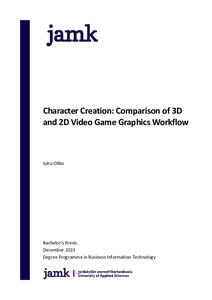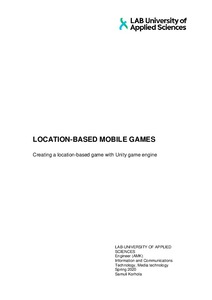Character Creation: Comparison of 3D and 2D Video Game Graphics Workflow
Ollila, Juho (2023)
Ollila, Juho
2023
All rights reserved. This publication is copyrighted. You may download, display and print it for Your own personal use. Commercial use is prohibited.
Julkaisun pysyvä osoite on
https://urn.fi/URN:NBN:fi:amk-2023121236606
https://urn.fi/URN:NBN:fi:amk-2023121236606
Tiivistelmä
Indie video games are rising in popularity. Developing video games as a single person has been a thing since the start of the industry. However, it is not easy, especially with rise in competition. As a developer, one of the choices that needs to be made is whether to develop a game in 2D or 3D. There is a lack of guidance in terms of academic research to help this decision. The goal was to produce academic research to give helpful information, rather than attempting to answer if one is better than the other. This information is aimed to help game developers make their choice.
The workflow of creating 2D and 3D graphics for a video game was compared. The objective was to find what benefits do both 2D and 3D graphics have and finding steps to ease the process of creating animations for them later. The research method chosen to complete these objectives was action research. A framework was created through qualitative research via a literature review about creating graphics and video game character design. This was used in a practical implementation where a video game character was first designed and then created in both 2D and 3D.
The major conclusion from the results of the practical implementation is that 2D workflow is quicker and arguably easier than 3D workflow, but the latter is more flexible for adjustments later. Using armature models ease animating at a later stage with both graphical styles. A 2D character likely requires new assets to be drawn when adding different animations. With 3D on the other hand the model can be utilized and manipulated easily for creating new animations.
The workflow of creating 2D and 3D graphics for a video game was compared. The objective was to find what benefits do both 2D and 3D graphics have and finding steps to ease the process of creating animations for them later. The research method chosen to complete these objectives was action research. A framework was created through qualitative research via a literature review about creating graphics and video game character design. This was used in a practical implementation where a video game character was first designed and then created in both 2D and 3D.
The major conclusion from the results of the practical implementation is that 2D workflow is quicker and arguably easier than 3D workflow, but the latter is more flexible for adjustments later. Using armature models ease animating at a later stage with both graphical styles. A 2D character likely requires new assets to be drawn when adding different animations. With 3D on the other hand the model can be utilized and manipulated easily for creating new animations.
Kokoelmat
Samankaltainen aineisto
Näytetään aineisto, joilla on samankaltaisia nimekkeitä, tekijöitä tai asiasanoja.
-
Game Development in Unity : Game Production, Game Mechanics and the Effects of Gaming
Dansie, Jason (Metropolia Ammattikorkeakoulu, 2013)The goal of this thesis is to examine how video games are designed and to see how differ-ent game mechanics work and how to use them in the development of a game, as well as examine what are both the positive and negative ... -
Location-based mobile games : creating a location-based game with the Unity game engine
Korhola, Samuli (2020)The subject of this thesis is location-based mobile games. Location-based mobile games are a way for mobile games to combine reality with virtual worlds and thus re-define the gaming experience. This thesis presents ... -
”WE WANT A 3D GAME” : Customer expectations for the games company when buying a serious game
Sorppanen, Mikko (Oulun seudun ammattikorkeakoulu, 2012)All digital games are not used for entertainment. Some of them can also be used for non-entertainment purposes and these games are called serious games. This thesis is carried out in co-operation with one Finnish games ...



